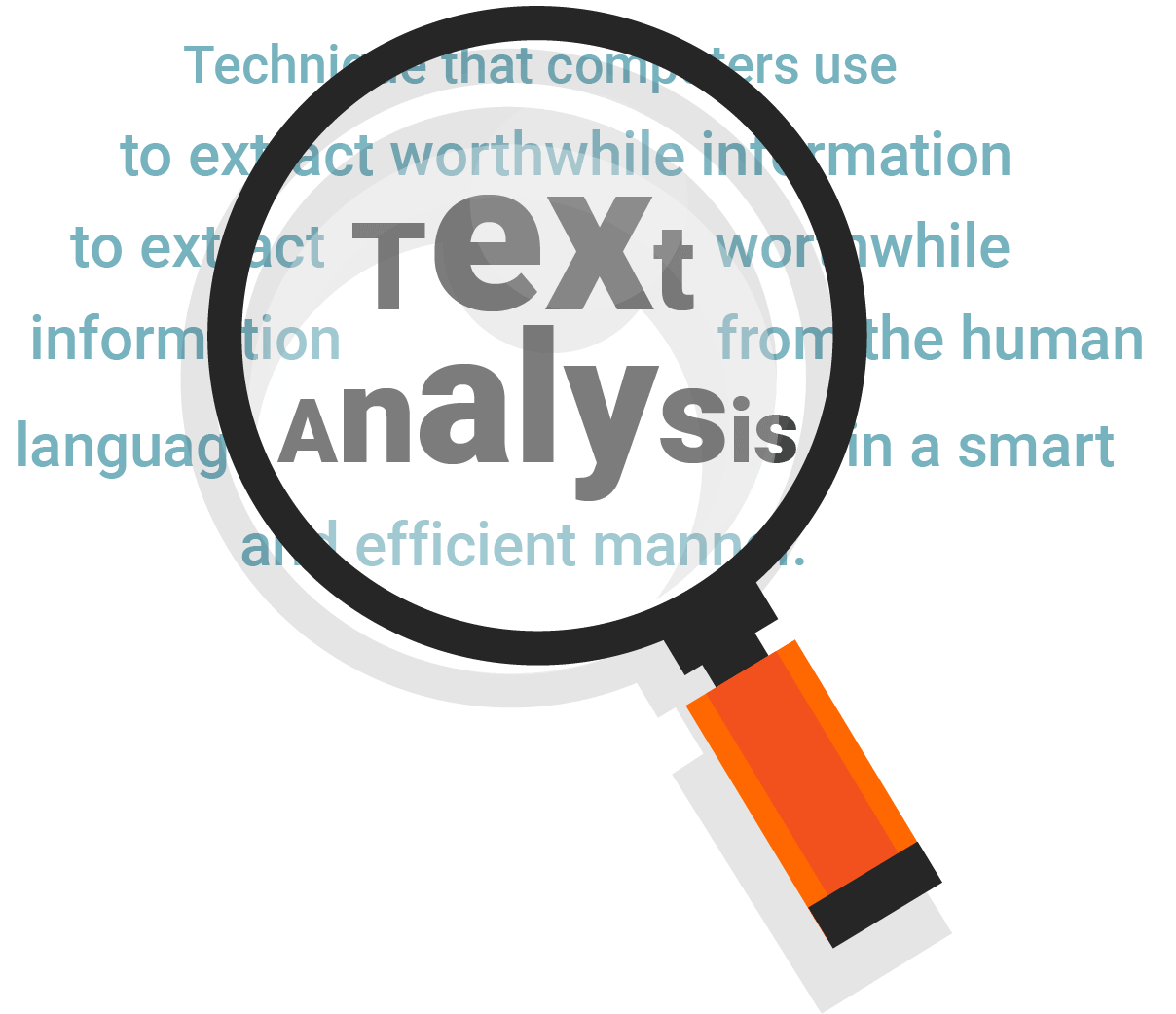
Watch the 1-minute tour
Text analysis (also known as Text Mining or Content Analysis) is a technique that computers use to extract worthwhile information from the human language in a smart and efficient manner. Researchers and developers can use this method to assemble diverse and unorganized data in a structured form. In this process, documents are disintegrated for hassle-free management of data pieces, simply put: unstructured text gets converted into structured data.
Once the sentences are put to paper, the integral sections such as the proper nouns are branched off using the list of words in the dictionary. The analysis of text, those in either documents or graphics, qualitative details can be transformed into quantitative details. It’s safe to establish text analysis is a research approach adapted to put together reasonable conclusions by decoding the content.
Developers and researchers use text analysis for establishing correlation between two entities, automated summary generation, translation, speech recognition and other similar content management tasks that come their way. If we talk about the business aspect, text analysis offers many wider subjects such as semantic search and content management to gather information.
Conduct quicker qualitative market research and quantitative market research by implementing text analysis as it emphasizes all the important terms and categorizes the responses for open-ended questions in particular.
For survey makers, it’s crucial to analyze the responses received for their surveys and analyzes of the open-ended responses can be done using text analysis. A text analysis software will be useful to organizations who want their unstructured data to get structured by observing patterns in the text and converting data into computer-readable formats. Text analysis software for sentiment analysis or linguistic analysis or quantitative text analysis can be used to convert text into practical information that can be influential in making smart decisions for the business.
Thousands of valuable data received through surveys or any other medium can be analyzed using these text analysis techniques. The first step in this retrieval and analysis process is to identify textual information over the internet or on the files in the computer system or database.
- Linguistic Analysis:
Usually, the major concern of building content is whether a sentence is self-sufficient or not but the true essence of a language is how well connected are the multiple sentences and how meaningful is the entire content for the audience.
Text analysis software usually implement advanced statistical techniques but other techniques like extensive natural language progression methods such as speech tagging or any other language analysis methods.
It was originally used to reveal grammatical errors in a piece of content but has eventually evolved into being a method used to evaluate the broader senses of text such as the context of a particular sentence i.e whether it’s interactive or not. The author, as well as the target audience, are considered while drawing conclusions using this method.
- Named Entity Recognition (NER):
Also known as entity extraction or entity identification), this is a geographical index text analysis method used to analyze named text parameters and designate them into pre-defined categories such as location names, individuals or acronyms. NER relies on grammatical techniques or numerical analysis techniques or both to generate an excerpt from text.
A NER analysis occurs when an undefined sentence such as: “Jack owns a 300 acre farm since 2001.” into a defined one such as: “Jack[Person] owns a 300 acre farm in Nashville[Location] since 2001[Time].”
- Sentiment Analysis:
Probing into the mood and feelings of customer feedback provided via call, website or social media pages can be integral in faster problem solving and enhancement of customer satisfaction. It helps you to understand how well your products/services are faring with your target market or what can be improved in comparison to the others in the market.
Extract information about emotions and attitudes using computational methods by identifying, quantifying and learning about subjective data. Insights into respondents’ emotions, moods or opinions are tracked using sentiment analysis (opinion mining) are analyzed to deliver better results.
There are 3 primary ways in which sentiment analysis is conducted.
- ‘Happy’ to ‘Sad’ or 0-10 scale where the customers are supposed to enter what according to them defines their experiences with your organization. You can work on improving or maintaining your customer experience on the basis of this score.
- Understand whether the customers have had extremely positive or negative experiences using polar analysis.
- By categorizing their feelings in details for example, expressing how angry or frustrated they are with the customer support team.
- Quantitative text analysis:
This analysis technique is used by humans and also computers to establish either grammatical or definitive equations between words. This will be able to give meaning to the patterns that exist in content.
There are 3 steps to conduct this technique:
- Pick out sections of text for analysis.
- Quantitative text parameters such as the word count, parts of speech, content category and others are to be extracted to be entered into a quantitative matrix.
- To make sure appropriate conclusions about the text or the author are made, this matrix should be analyzed using statistical analysis methods.
- Contextual Analysis:
Contextual analysis allows the researcher to analyze the text by taking various factors such as cultural, social or historical factors under consideration and considers the circumstances under which a particular piece of content came into being. Questions similar to: “What were the factors that led to this text?” or “What does this text have to say about the target audience?” get answered using this technique.
The best way to establish context is to figure out a correlation between a noun and other related terms which are neighbors of the keywords along with analyzing the association between multiple terms in content.
- Named Entity Disambiguation (NED):
Also called entity linking, it’s a concept that offers recognition and formation of concepts from content and it doesn’t depend on statistical analysis like NER to extract concepts and it also doesn’t retrieve specific entities. For instance, in a sentence, “Steve jobs was integral towards Apple’s success.” the concept is about Apple the brand and not the fruit. This is manifested using entity linking but it requires an entity knowledge base that’ll contain all the entity mentions in the text.
Text analysis is a fairly new concept in the computer science that involves making huge quantities of unorganized data congenial and constructive. This helps in increasing value of the data as well as elevating this data can be used in risk management or paths such as cybercrime.
Here are 5 text analysis examples to create awareness about the applications of text mining in today’s world:
- Prevention of cyber crimes:Due to the nature of how the internet operates, it’s a highly vulnerable medium for data sharing and communication. This has opened doors for a lot of unforeseen cyber crimes which can be prevented using text analysis. It’s probably one of the very few techniques being used to prevent cyber crimes.
- Efficient customer service:This is one of the basic examples of text analysis which caters to improving customer service using mediums such as survey software or customer satisfaction calls to make better products or services. This technique helps in building customer trust by providing quick and automated responses to them in times when they need assistance. This happens as their dependence on operators reduces drastically and saves them a lot of time.
- Advertising via digital mediums:These days, advertising firms rely on digital mediums to gather reliable results. Text analysis is one of the most critical tools that advertising firms use to obtain precise 360-degree results. In comparison to traditional advertising methods such as the cookie-based approaches, it has an edge in terms of the secured privacy it offers along with accurate results.
- Enhance your content:Content generation relies on human effort but it eases the process of content creation as far as managing the sizeable bulk of data is concerned. Using text analysis, content can be enhanced by added multiple aspects such as organizing or giving the content an outline to make it applicable to more than one implementations.
- Data analysis for social media networks:Social media is the most effective mediums to get in touch with your target audience to get feedback, reviews, and criticism to improve and also gives access to a pool of data. Companies are developing social media strategies to get insights about their product performances and to also understand the buyer’s persona so that making improvements can have a defined path. That’s where text analysis comes in. It makes analyzing humongous amount data, deriving results from the analysis and also understanding user feedback and emotions easier to implement.
The implementation of a software is just the start of the entire process of utilizing data. A large amount of data is analyzed and the result of this analysis is entered into sheets which are then scanned for observing data patterns, to offer systematic closure to the text, use the retrieved information to make the text better and avoid restricting yourself to keywords.
 Survey Software
Easy to use and accessible for everyone. Design, send and analyze online surveys.
Survey Software
Easy to use and accessible for everyone. Design, send and analyze online surveys.
 Research Suite
A suite of enterprise-grade research tools for market research professionals.
Research Suite
A suite of enterprise-grade research tools for market research professionals.
 CX
Experiences change the world. Deliver the best with our CX management software.
CX
Experiences change the world. Deliver the best with our CX management software.
 Workforce
Create the best employee experience and act on real-time data from end to end.
Workforce
Create the best employee experience and act on real-time data from end to end.











